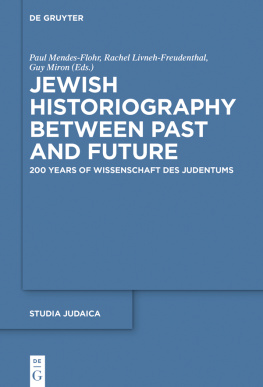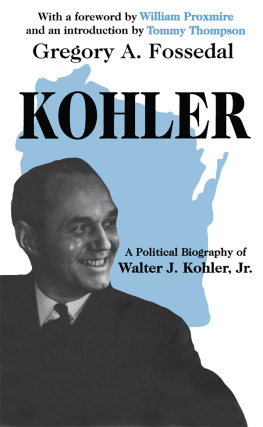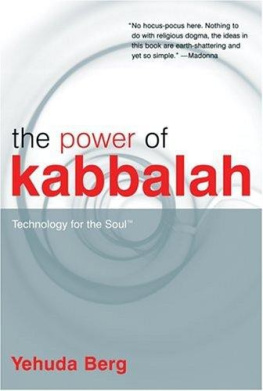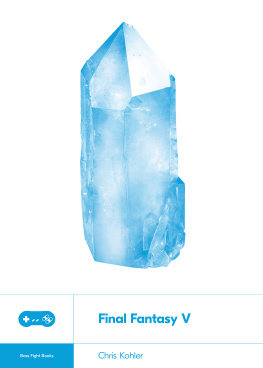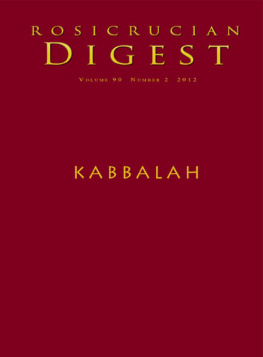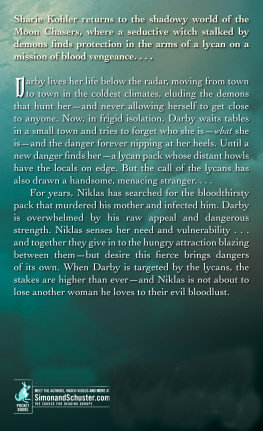George Y. Kohler - Kabbalah Research in the Wissenschaft Des Judentums 1820-1880
Here you can read online George Y. Kohler - Kabbalah Research in the Wissenschaft Des Judentums 1820-1880 full text of the book (entire story) in english for free. Download pdf and epub, get meaning, cover and reviews about this ebook. year: 2019, publisher: De Gruyter, genre: Religion. Description of the work, (preface) as well as reviews are available. Best literature library LitArk.com created for fans of good reading and offers a wide selection of genres:
Romance novel
Science fiction
Adventure
Detective
Science
History
Home and family
Prose
Art
Politics
Computer
Non-fiction
Religion
Business
Children
Humor
Choose a favorite category and find really read worthwhile books. Enjoy immersion in the world of imagination, feel the emotions of the characters or learn something new for yourself, make an fascinating discovery.
- Book:Kabbalah Research in the Wissenschaft Des Judentums 1820-1880
- Author:
- Publisher:De Gruyter
- Genre:
- Year:2019
- Rating:5 / 5
- Favourites:Add to favourites
- Your mark:
- 100
- 1
- 2
- 3
- 4
- 5
Kabbalah Research in the Wissenschaft Des Judentums 1820-1880: summary, description and annotation
We offer to read an annotation, description, summary or preface (depends on what the author of the book "Kabbalah Research in the Wissenschaft Des Judentums 1820-1880" wrote himself). If you haven't found the necessary information about the book — write in the comments, we will try to find it.
Kabbalah Research in the Wissenschaft Des Judentums 1820-1880 — read online for free the complete book (whole text) full work
Below is the text of the book, divided by pages. System saving the place of the last page read, allows you to conveniently read the book "Kabbalah Research in the Wissenschaft Des Judentums 1820-1880" online for free, without having to search again every time where you left off. Put a bookmark, and you can go to the page where you finished reading at any time.
Font size:
Interval:
Bookmark:

George Y. Kohler
Kabbalah Research in the Wissenschaft des Judentums (18201880)
Europisch-jdische Studien
Beitrge

Herausgegeben vom Moses Mendelssohn Zentrum fr europisch-jdische Studien, Potsdam
Redaktion: Werner Tre
Band 47
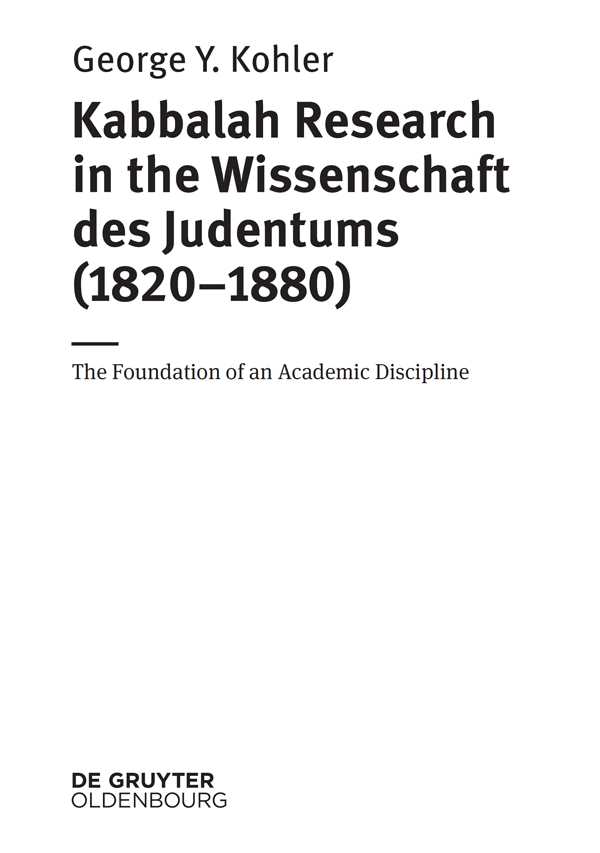
ISBN 978-3-11-062037-5
e-ISBN (PDF) 978-3-11-062396-3
e-ISBN (EPUB) 978-3-11-062042-9
ISSN 2192-9602
Library of Congress Cataloging in Publication Control Number: 2019932238
Bibliografische Information der Deutschen Nationalbibliothek
Die Deutsche Nationalbibliothek verzeichnet diese Publikation in der Deutschen Nationalbibliografie; detaillierte bibliografische Daten sind im Internet ber http://dnb.dnb.de abrufbar.
2019 Walter de Gruyter GmbH, Berlin/Boston
www.degruyter.com
The research for this book was funded by the Fritz Thyssen Foundation within the context of a collaborative German-Israeli research project of the Goethe-University Frankfurt am Main (Christian Wiese and Amir Engel) and the Ben-Gurion University of the Negev in Beer Sheva (Boaz Huss and George Y. Kohler). The project was devoted to the topic The Academic Study of Jewish Mysticism in the Modern Period (18301941). Generously supported by the Thyssen Foundation, it aimed to revisit the neglected role of Kabbalah and the research of Jewish mysticism in pre-Scholem European culture.
Personally I would like to thank my partners in this project Christian Wiese and Amir Engel for all their help and encouragement, but especially Boaz Huss for reading and commenting on the manuscript. Not being a kabbalah scholar myself, this was decisive for the academic quality of the book. Nevertheless, all remaining errors are still my own.
In addition I am grateful to all the people who helped to produce the manuscript: Dr. Julie Chajes, my old friend Robert Klein, and Sara Tropper from Soaring Sentences Ltd. A special thanks goes to Julia Brauch and Werner Tre who immediately understood that this book has the potential to change some conceptions still predominant for the field of the history of kabbalah research, and to the entire team at de Gruyter, who it is such a pleasure to work with. Last but not least, I would like to thank my family for their patience and above all my wife, Dr. Noa Sophie Kohler, for simply everything.
In 1877, George Eliot sent a desperate letter to her German bookseller, Nicholas Trbner, asking him When will another Lieferung of Hamburger come out? When George Eliot wrote her famous novel Daniel Deronda , she based much of the mystical knowledge she put into the mouth of one of the works main protagonists, Ezra Mordecai Cohen, a kabbalist and proto-Zionist, on what she had studied in the first two sections of Volume II of Hamburgers encyclopedia, available at the time of the publication of the novel.
When the second volume of the Realencyclopdie appeared in 1883, the first entry under the letter K was on Kabbala, stretching over a full forty-five pages and reproducing all the knowledge on this stream of Jewish mysticism available at the time of Hamburgers writing the article. That such an impressive encyclopedic entry became possible already in the 1880s was the result of the concentrated effort of the scholars of the German Jewish movement of Wissenschaft des Judentums to research the origins, texts, and main figures of Kabbalah and Jewish mysticism. Almost from the very beginnings of the Wissenschaft movement in the 1820s until Heinrich Graetzs major essays on the subject of mysticism in the 1860s, German Jewish scholars produced results that were repeatedly revalidated far into the 20th century. Pioneering figures of manuscript study like Meir Hirsch Landauer and Adolf Jellinek worked on this ambitious project closely together with historians like Isaak Markus Jost and bibliographers like Moritz Steinschneider. Moreover, theologians like Abraham Geiger, Leopold Loew, and Leopold Stein also made interesting contributions to the Kabbalah research of the Wissenschaft des Judentums, placing Jewish mysticism within the wider intellectual tradition of Judaism by working out the relation of Kabbalah to what they perceived as the theological essence ( Wesen ) of Judaism an endeavor that was very typical for the religious discourse of the nineteenth century in Western Europe.
It is to these developments, scholars and scholarly works that the present study is devoted. It will follow the discourse on Kabbalah within the Wissenschaft des Judentums chronologically, through several decades of work. The story of modern Kabbalah research arguably began in 1838, when the young Jewish scholar Meir Hirsch Landauer decided that there was no better place to begin his kabbalistic manuscript studies than the Court Library in Munich. There he read hundreds of manuscripts concerning Jewish mysticism, and soon a new world opened up for him. Fascinated by what he had read, he developed several highly original theories about the history and essence of Kabbalah. In the fall of 1842, another young man interested in Kabbalah came to the city of Leipzig, then the stronghold of German orientalism, and soon this scholar would turn into a worthy successor of Landauer, for whom he had great respect. During the almost fifteen years of his stay in Leipzig, Adolf Jellinek (18201889) became the leading and most industrious German-Jewish scholar of kabbalistic thought of his time, probably even of the entire nineteenth century. Indeed, in just the first half of the 1850s alone, Jellinek published no less than five books on Kabbalah in which he corrected most of Landauers theories. It should also be noted that still in the 1850s, another scholar, Moritz Steinschneider, catalogued all known kabbalistic works in a ten-page list included in his famous essay Jewish Literature (1857).
In parallel to this development, several young Jewish theologians produced detailed and sophisticated theories of the emergence of kabbalistic thought, with which they all seem to have been well-acquainted, at least concerning its main works, like the Sefer Yezirah and the Sefer haZohar. Even earlier, in 1840, Abraham Geiger had already published a philosophical analysis of the emergence of Kabbalah within Judaism, claiming it was a direct result of the theological confrontation between the talmudic and philosophical schools in the history of the Jewish religion. In 1846, the young Heinrich Graetz made the connection between gnosis and Kabbalah, analyzing in depth the Sefer Yezirah, while in 1849 Rabbi David Joel wrote an ambitious book on the more intellectual aspects of the Sefer haZohar. A lengthy and groundbreaking philological study of the same work was published in 1858 by Ignatz Stern, re-opening the question of its authorship, a question that Adolf Jellinek had presumably already settled with his establishing the Spanish kabbalist Moses de Leon (12501305) as the main originator of the Zohar. Stern showed that this subject was far more complex: he was convinced that the Zohar is essentially a patchwork of at least three layers of text, from different periods of time, transitioning one into the other a claim that is essentially valid until today.
The 1860s belonged to Heinrich Graetzs grandiose History of the Jews , a work that would eventually span eleven volumes and which fundamentally changed German Jewish identity during the nineteenth century. Of special interest is the seventh volume from 1863, in which Graetz devoted two full chapters and two essay-long endnotes to the Kabbalah, demonstrating the surprising amount of manuscript study he had undertaken to produce his research results. Graetz re-established Moses de Leon as the author of the Zohar , but provided a much more detailed fundament for modern Kabbalah research by referring to several minor figures of kabbalistic thought until the eighteenth century. In addition, Graetz discussed at length the great Christian kabbalists of the Renaissance period, and in particular, Johannes Reuchlin and his appropriation of Kabbalah for the proof of the truth of Christianity. Later, in the 1880s, lengthy accounts of Kabbalah found entrance even into textbooks for use by Jewish school teachers, published by Wissenschaft scholars like David Cassel and Gustav Karpeles, and eventually also into Jacob Hamburgers first Jewish encyclopedia.
Font size:
Interval:
Bookmark:
Similar books «Kabbalah Research in the Wissenschaft Des Judentums 1820-1880»
Look at similar books to Kabbalah Research in the Wissenschaft Des Judentums 1820-1880. We have selected literature similar in name and meaning in the hope of providing readers with more options to find new, interesting, not yet read works.
Discussion, reviews of the book Kabbalah Research in the Wissenschaft Des Judentums 1820-1880 and just readers' own opinions. Leave your comments, write what you think about the work, its meaning or the main characters. Specify what exactly you liked and what you didn't like, and why you think so.



